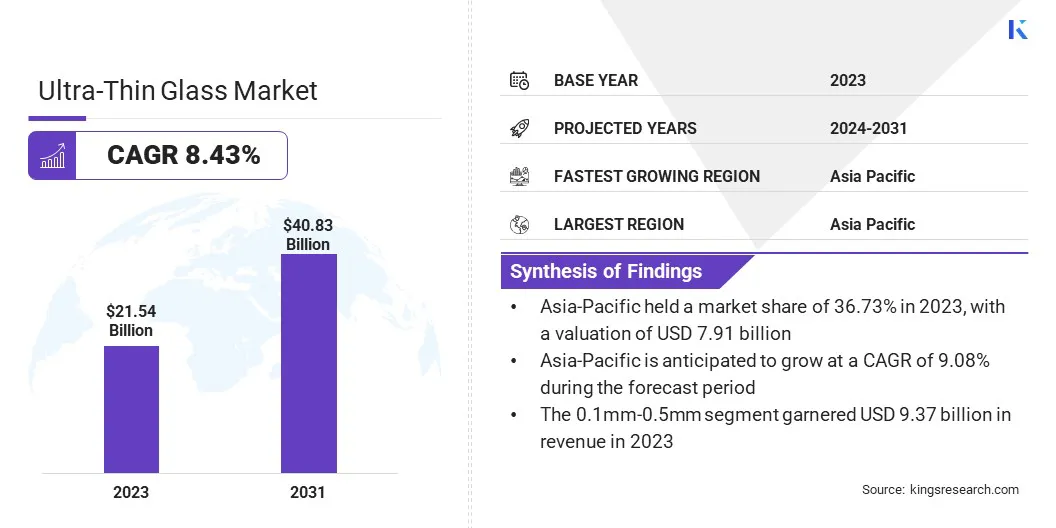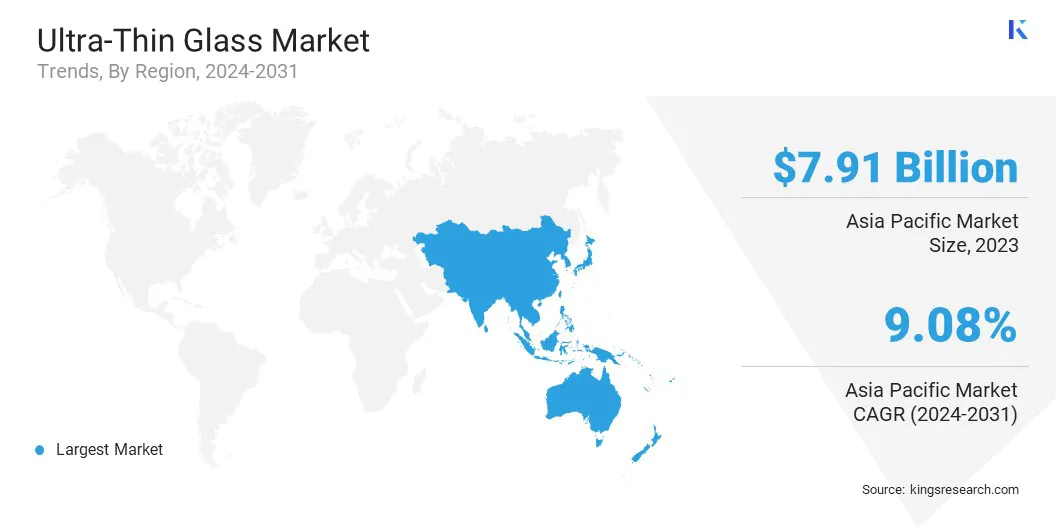Market Definition
The ultra-thin glass market involves the production, distribution, and application of glass thinner than 0.1 mm. Known for its flexibility, strength, and transparency, it is widely used in electronics, automotive, solar energy, and consumer goods industries.
Ultra-thin Glass Market Overview
The global ultra-thin glass market size was valued at USD 21.54 billion in 2023 and is projected to grow from USD 23.17 billion in 2024 to USD 40.83 billion by 2031, exhibiting a CAGR of 8.43% during the forecast period. This growth is driven by growing demand for advanced, lightweight materials that enable miniaturization and improve technological performance.
The rapid advanecment of consumer electronics, including smartphones, tablets, and wearables, is highlighting the need for thinner, more durable, and flexible glass.
Major companies operating in the global ultra-thin glass industry are AGC Inc., Changzhou Almaden Co., Ltd, Nippon Electric Glass Co., Ltd., SCHOTT, Luoyang Float Glass Group Co., Ltd., Xinyi Glass Holdings Limited., Nitto Boseki Co., Ltd., CSG HOLDING CO., LTD, Taiwan Glass China Holding Ltd., GENTEX CORPORATION, Corning Incorporated, Noval Glass, Emerge Glass, Nippon Sheet Glass Co., Ltd, and Abrisa Technologies.
The automotive industry's shift toward lightweight, energy-efficient materials, along with the rising adoption of solar energy technologies, is further fueling the demand for ultra-thin glass.
Advancements in manufacturing techniques, such as roll-to-roll production and chemical vapor deposition, are expected to enhance the cost efficiency and scalability, further supporting its widespread adoption.
- In September 2024, Glaston Corporation and Corning Incorporated collaborated to advance ultra-thin architectural glass processing, fostering innovation and expanding design possibilities.

Key Highlights:
- The global ultra-thin glass market size was recorded at USD 21.54 billion in 2023.
- The market is projected to grow at a CAGR of 8.43% from 2024 to 2031.
- Asia-Pacific held a share of 36.73% in 2023, valued at USD 7.91 billion.
- The 0.1mm-0.5mm segment garnered USD 9.37 billion in revenue in 2023.
- The consumer electronics segment is expected to reach USD 16.69 billion by 2031.
- North America is anticipated to grow at a CAGR of 8.55% over the forecast period.
Market Driver
"Rising Demand in Consumer Electronics"
The rising demand in consumer electronics is propelling the growth of the ultra-thin glass market. As consumer demand grows for sleek, high-performance devices, manufacturers are turning to ultra-thin glass for its strength, flexibility, and transparency.
Widely used in smartphones, tablets, laptops, and wearables, it enhances durability, scratch resistance, and display quality while maintaining a lightweight, slim profile. Its optical clarity makes it ideal for applications such as touchscreens, OLED displays, and curved or foldable screens.
- In August 2024, Nippon Electric Glass Co., Ltd. announced that its "Dinorex UTG™" ultra-thin glass for chemical strengthening has been selected as the display cover glass of Motorola Mobility LLC.’s motorola razr 50 series, launched on June 25, 2024.
Market Challenge
"Complexity in Ultra-thin Glass Manufacturing"
The manufacturing complexity of ultra-thin glass is a significant challenge due to the advanced techniques required for precision and quality. Maintaining uniform thickness is essential for strength and optical clarity, necessitating specialized equipment and strict quality control. Its fragile nature increases the risk of breakage, requiring careful handling, packaging, and transportation.
Balancing flexibility and strength is particularly challenging for applications such as foldable displays or automotive glass. Additionally, achieving high-quality surface finishes, uniform coatings, and application-specific customization further complicates the production process.
Addressing the manufacturing challenges of ultra-thin glass requires significant investment in advanced technologies, process optimization, and innovation. Enhancing automation minimizes human intervention, reduces errors, and ensures consistency.
Improved material handling and advanced coatings can enhance durability and flexibility without compromising thinness. To tackle scalability challenges, modular manufacturing systems that adapt to both small and large-scale production can be implemented while ensuring high quality.
Market Trend
"Advancements in OLED and Display Technology"
As OLED technology advances, the demand for lightweight, flexible, and durable glass for high-definition displays has increased. The shift toward 4K and 8K resolutions, along with innovations in flexible and transparent OLEDs, highlights the need for ultra-thin glass that ensures structural integrity without compromising visual quality.
As manufacturers expand OLED capabilities, ultra-thin glass remains essential for enabling emerging display formats such as bendable and rollable screens, fueling transformation in consumer electronics and entertainment.
- In February 2023, Samsung Display announced its participation in MWC 2023 under the theme of Hyper-Connected through OLED. The company showcases the lightweight, durable and water-resistant properties of its OLED technology through interactive demonstrations.
Ultra-thin Glass Market Report Snapshot
|
Segmentation
|
Details
|
|
By Thickness
|
<0.1mm, 0.1mm-0.5mm, 0.5mm-1.0mm
|
|
By Application
|
Consumer Electronics, Automotive & Transportation, Medical & Healthcare, Others (Semiconductor, solar panels, architectural glazing, and other specialized fields)
|
|
By Region
|
North America: U.S., Canada, Mexico
|
|
Europe: France, UK, Spain, Germany, Italy, Russia, Rest of Europe
|
|
Asia-Pacific: China, Japan, India, Australia, ASEAN, South Korea, Rest of Asia-Pacific
|
|
Middle East & Africa: Turkey, UAE, Saudi Arabia, South Africa, Rest of Middle East & Africa
|
|
South America: Brazil, Argentina, Rest of South America
|
Market Segmentation
- By Thickness (<0.1mm, 0.1mm-0.5mm, and 0.5mm-1.0mm): The 0.1mm-0.5mm segment earned USD 9.37 billion in 2023 due to its widespread use in applications such as flexible displays, automotive windows, and lightweight electronics.
- By Application (Consumer Electronics, Automotive & Transportation, Medical & Healthcare, and Others (Semiconductor, solar panels, architectural glazing, and other specialized fields)): The consumer electronics segment held a share of 41.03% in 2023, attributed to the increasing demand for ultra-thin glass in smartphones, tablets, wearables, and other advanced display technologies.
Ultra-thin Glass Market Regional Analysis
Based on region, the global market has been classified into North America, Europe, Asia Pacific, Middle East & Africa, and Latin America.

Asia Pacific ultra-thin glass market share stood at around 36.73% in 2023, valued at USD 7.91 billion, characterized by rapid technological advancements and the presence of major electronics manufacturers in countries such as China, Japan, and South Korea.
The region serves as a key hub for consumer electronics production, including smartphones, tablets, and OLED displays, boosting ultra-thin glass demand. Additionally, the expanding automotive industryis highlighting the need for lightweight, durable materials such as ultra-thin glass.
- In February 2025, OPPO nnounced the global launch of its Find N5, the world's thinnest book-style foldable smartphone, featuring an innovative design, extended battery life, and AI-enhanced performance.. Find N5's Dual Shielded Flexible Screen includes nine layers, including an industry-leading 0.1mm thin stainless steel support plate, ultra-thin glass, and a top film made of customized anti-shock elastomer material.
North America ultra-thin glass industry is estimated to grow at a CAGR of 8.55% over the forecast period. This growth is fostered by continual technological advancements, particularly in OLED display technologies and next-generation automotive features such as electric vehicles (EVs) and autonomous driving systems.
The growing adoption of smart devices and wearables, along with the expansion of energy-efficient building materials in architecture, is boosting demand for ultra-thin glass.
North America's strong emphasis on innovation and sustainability, coupled with the presence of key industry players and research institutions, is expected to create a favorable environment for regional market expansion.
Regulatory Frameworks:
- The Bureau of Indian Standards (BIS) enforces IS 2553, which sets safety and quality standards for industrial and commercial glass products.
- The Occupational Safety and Health Administration (OSHA) mandates the use of Personal Protective Equipment (PPE) to ensure the safety of workers exposed to hazardous environments.
- The International Organization for Standardization (ISO) implements ISO 9001:2015, outlining guidelines for an effective quality management system (QMS) to ensure consistent product quality and customer satisfaction.
Competitive Landscape
The competitive landscape of the ultra-thin glass market is characterized by a mix of established industry leaders and emerging players vying for market share through innovation, technological advancements, and strategic partnerships.
Market participants are improving production techniques, enhancing material properties, and expanding applications across various sectors, including consumer electronics, automotive, and renewable energy.
Key competitive strategies focus on developing more flexible, durable, and cost-effective ultra-thin glass to meet the growing demand for flexible displays, foldable devices, and energy-efficient solutions.
- In November 2023, PGT Innovations launched Triple Diamond Glass, a subsidiary focused on providing advanced energy efficiency, security, and sound abatement solutions for window and door manufacturers, marking a key milestone in its strategic growth.
List of Key Companiesin Ultra-thin Glass Market:
- AGC Inc.
- Changzhou Almaden Co., Ltd
- Nippon Electric Glass Co., Ltd.
- SCHOTT
- Luoyang Float Glass Group Co., Ltd.
- Xinyi Glass Holdings Limited.
- Nitto Boseki Co., Ltd.
- CSG HOLDING CO., LTD
- Taiwan Glass China Holding Ltd.
- GENTEX CORPORATION
- Corning Incorporated
- Noval Glass
- Emerge Glass
- Nippon Sheet Glass Co., Ltd
- Abrisa Technologies
Recent Developments (M&A/Partnerships/Agreements/New Product Launch)
- In January 2025, AGC Glass Europe, the European division of AGC, a leading glass manufacturer, announced a major investment in a new insulating vacuum glass production line at its Lodelinsart site in Belgium. This initiative underscores AGC's AGC's commitment to innovation and advanced technology to meet evolving customer demands
- In December 2024, Glas Trösch partnered with Corning Incorporated to develop a prototype triple insulation glass. Debuting at the BAU trade fair in Munich, this pane is just 0.5 millimetres thick, making it significantly thinner and lighter than standard float glass


